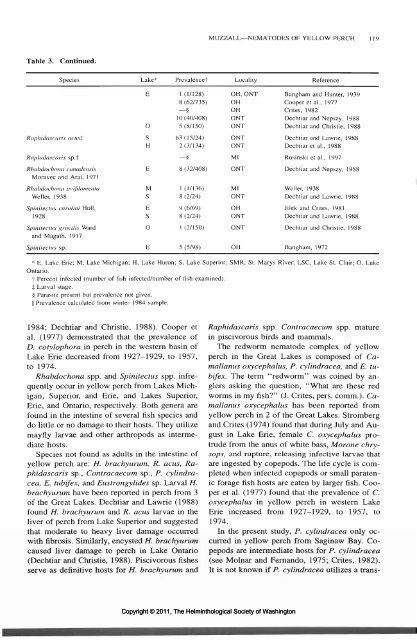The Helminthological Society of Washington - Peru State College
The Helminthological Society of Washington - Peru State College
The Helminthological Society of Washington - Peru State College
You also want an ePaper? Increase the reach of your titles
YUMPU automatically turns print PDFs into web optimized ePapers that Google loves.
MUZZALL—NEMATODES OF YELLOW PERCH 19<br />
Table 3. Continued.<br />
Species<br />
Lake*<br />
Prevalencet<br />
Locality<br />
Reference<br />
Raphidascaris acus$<br />
Raphidascaris sp.t<br />
Rhabdochona canadensis<br />
Moravec and Aral, 1971<br />
Rhabdochona ovtfikanenta<br />
Weller, 1938<br />
Spinitectux carolini Roll,<br />
1928<br />
E<br />
0<br />
S<br />
11<br />
E<br />
M<br />
S<br />
E<br />
S<br />
1 (1/128)<br />
8 (62/735)<br />
— §<br />
10(40/408)<br />
5(8/150)<br />
63(15/24)<br />
2(3/134)<br />
— §<br />
8 (32/408)<br />
1 (1/136)<br />
8 (2/24)<br />
9 (6/69)<br />
8 (2/24)<br />
OH, ONT<br />
OH<br />
OH<br />
ONT<br />
ONT<br />
ONT<br />
ONT<br />
Spinitectus gracilis Ward 0<br />
1 (2/150) ONT<br />
Dechtiar and Christie, 1988<br />
and Magath, 1917<br />
Spinitectus sp. 5 (5/98) OH Bangham, 1972<br />
* E, Lake Erie; M, Lake Michigan; H, Lake Huron; S, Lake Superior;<br />
Ontario.<br />
t Percent infected (number <strong>of</strong> fish infected/number <strong>of</strong> fish examined).<br />
± Larval stage.<br />
S Parasite present but prevalence not given.<br />
|| Prevalence calculated from winter 1984 sample.<br />
MI<br />
ONT<br />
MI<br />
ONT<br />
OH<br />
ONT<br />
Bangham and Hunter, 1939<br />
Cooper et al., 1977<br />
Crites, 1982<br />
Dechtiar and Nepszy, 1988<br />
Dechtiar and Christie, 1988<br />
Dechtiar and Lawrie, 1988<br />
Dechtiar et al., 1988<br />
Rosinski et al., 1997<br />
Dechtiar and Nepszy, 1988<br />
Weller, 1938<br />
Dechtiar and Lawrie, 1988<br />
Jilek and Crites, 1981<br />
Dechtiar and Lawrie, 1988<br />
SMR, St. Marys River; LSC, Lake St. Clair; O, Lake<br />
1984; Dechtiar and Christie, 1988). Cooper et<br />
al. (1977) demonstrated that the prevalence <strong>of</strong><br />
D. cotylophora in perch in the western basin <strong>of</strong><br />
Lake Erie decreased from 1927-1929, to 1957,<br />
to 1974.<br />
Rhabdochona spp. and Spinitectus spp. infrequently<br />
occur in yellow perch from Lakes Michigan,<br />
Superior, and Erie, and Lakes Superior,<br />
Erie, and Ontario, respectively. Both genera are<br />
found in the intestine <strong>of</strong> several fish species and<br />
do little or no damage to their hosts. <strong>The</strong>y utilize<br />
mayfly larvae and other arthropods as intermediate<br />
hosts.<br />
Species not found as adults in the intestine <strong>of</strong><br />
yellow perch are: H. brachyurum, R. acus, Raphidascaris<br />
sp., Contracaecum sp., P. cylindracea,<br />
E. tubifex, and Eustrongylides sp. Larval H.<br />
brachyurum have been reported in perch from 3<br />
<strong>of</strong> the Great Lakes. Dechtiar and Lawrie (1988)<br />
found H. brachyurum and R. acus larvae in the<br />
liver <strong>of</strong> perch from Lake Superior and suggested<br />
that moderate to heavy liver damage occurred<br />
with iibrosis. Similarly, encysted H. brachyurum<br />
caused liver damage to perch in Lake Ontario<br />
(Dechtiar and Christie, 1988). Piscivorous fishes<br />
serve as definitive hosts for H. brachyurum and<br />
Raphidascaris spp. Contracaecum spp. mature<br />
in piscivorous birds and mammals.<br />
<strong>The</strong> redworm nematode complex <strong>of</strong> yellow<br />
perch in the Great Lakes is composed <strong>of</strong> Camallanus<br />
oxycephalus, P. cylindracea, and E. tubifex.<br />
<strong>The</strong> term "redworm" was coined by anglers<br />
asking the question, "What are these red<br />
worms in my fish?" (J. Crites, pers. comm.). Camallanus<br />
oxycephalus has been reported from<br />
yellow perch in 2 <strong>of</strong> the Great Lakes. Stromberg<br />
and Crites (1974) found that during July and August<br />
in Lake Erie, female C. oxycephalus protrude<br />
from the anus <strong>of</strong> white bass, Morone chrysops,<br />
and rupture, releasing infective larvae that<br />
are ingested by copepods. <strong>The</strong> life cycle is completed<br />
when infected copepods or small paratenic<br />
forage fish hosts are eaten by larger fish. Cooper<br />
et al. (1977) found that the prevalence <strong>of</strong> C.<br />
oxycephalus in yellow perch in western Lake<br />
Erie increased from 1927-1929, to 1957, to<br />
1974.<br />
In the present study, P. cylindracea only occurred<br />
in yellow perch from Saginaw Bay. Copepods<br />
are intermediate hosts for P. cylindracea<br />
(see Molnar and Fernando, 1975; Crites, 1982).<br />
It is not known if P. cylindracea utilizes a trans-<br />
Copyright © 2011, <strong>The</strong> <strong>Helminthological</strong> <strong>Society</strong> <strong>of</strong> <strong>Washington</strong>
















